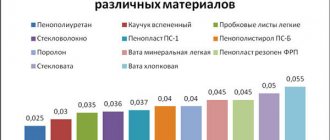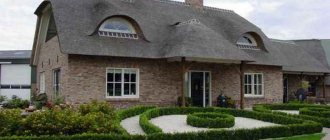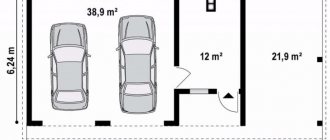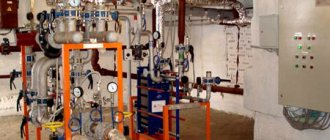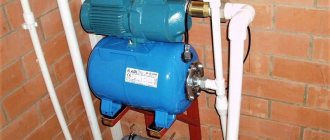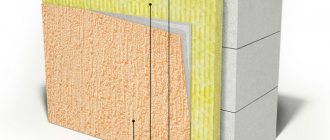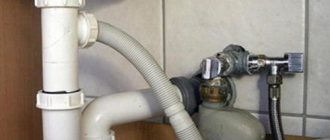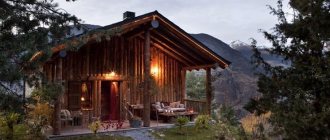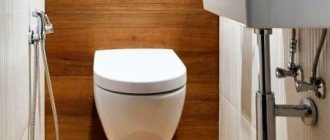The installation of a vapor barrier is an important stage in construction necessary to protect against the effects of water vapor on the insulation. The absence of such a layer during sudden temperature changes contributes to the deterioration of the characteristics of most building materials and a reduction in their service life. Moisture ingress also causes mold to appear on them.
Vapor barrier is installed using a variety of materials both from the outside and from the inside of the house. During installation, compliance with technology is required, as well as rules on which the quality of the finished work directly depends.
The principle of operation of vapor barrier in general
The main task is to create an obstacle to the permeability of vapors. Thanks to this property, the walls are protected from destruction from accumulated moisture (condensation). But the very definition of “vapor barrier” does not mean that the film creates a barrier and completely interferes with the circulation of steam. Modern materials are aimed at providing a slight air flow to eliminate the greenhouse effect in the house itself.
The best manufacturers
To purchase high-quality building materials, you need to focus, among other things, on the manufacturer. Choosing a reliable and trusted supplier will help you avoid possible problems. Let's look at the two most famous ones.
Where vapor barrier is needed
There is a category of premises where installing a vapor barrier is a mandatory measure. Such cases include the following:
- Premises with high temperatures and high air humidity, in particular baths and basements;
- The use of materials that become wet due to high humidity and lose all the characteristics declared by the manufacturer, deteriorating over time, for example, glass wool and mineral wool;
- In the construction of multilayer walls of frame houses, since condensation is likely to occur between the layers;
- When installing ventilated facades, in this option the vapor barrier makes the air flow weaker, protecting the insulation from excessive load, for example, a brick wall with cotton insulation and sheathed with siding.
What is vapor permeability
In order to make an informed choice, you need to understand exactly what vapor permeability is, what it depends on and what it affects. Vapor permeability is the property of materials to allow vapor molecules to pass through in the presence of a difference in partial vapor pressure and at the same atmospheric pressure on different sides of the material. Steam penetrates the fabric if the relative air humidity on both sides is different - this sounds simpler.
Vapor permeability indicator
Vapor permeability is determined by the vapor permeability coefficient and varies in mg/(m·h·Pa). Different materials have different vapor permeability coefficients. For example, extruded polystyrene foam has a vapor permeability coefficient of 0.013, mineral wool 0.5, and pine 0.06. These numbers indicate exactly how much steam the materials pass through within one hour in milligrams. In this case, the surface area is 1 m2, the thickness is 1 m, the air temperature on both sides is the same, and the difference in the partial pressure of water vapor on both sides is 1 Pa. Under these conditions, polypropylene allows approximately 7 mg of steam to pass through, and mineral wool 800 mg.
Vapor permeability of building materials
These are domestic standards, international ones differ from them. ISO/FDIS 10456:2007(E) show the coefficient of resistance to the movement of steam compared to air. In this case, it is taken into account that the air does not provide resistance, its coefficient is equal to unity. For a more accurate determination, another parameter is introduced - vapor permeability for dry and wet materials. All materials with humidity levels less than 70% are considered dry; if the humidity exceeds this value, then they are classified as wet. To make it easier to understand the definitions, let’s compare the vapor permeability indicators of some materials .
| Name of material | Vapor permeability according to domestic and international standards. |
Air | According to international standards, the vapor permeability indicator is equal to one for both dry and wet conditions. Not classified according to domestic standards. |
Concrete | According to the domestic classification, it has a vapor permeability of 0.03 mg/(m·h·Pa). According to international standards, dry 100, wet 60. |
Plastics | There are many varieties, but the vapor permeability indicators do not differ much. According to the international classification, approximately 1000, according to the domestic classification, approximately 0.05 mg/(m·h·Pa). |
Decide for yourself which definitions to use. But remember that a vapor permeability of 1000 means that the material is a thousand times worse at transmitting steam than air, that is, 1000 times less steam enters than in the absence of vapor protection.
Interesting to know. A few words should now be said about “breathing” buildings made of wood. The vapor permeability of wood is within 200 according to international standards. This means that there is no point in talking about breathing houses. If the air exchange rate in a room must be at least 10, then wooden walls provide only 1/200 of this exchange; the rest must be done through ordinary room ventilation.
Polyethylene
Traditionally available material with a thickness of only 1 mm. It should be fastened with concentration and care to prevent excessive tension, which could damage the film due to temperature changes.
There are several types of film protection:
- Perforated with small vapor-permeable holes;
- Non-perforated.
In the absence of perforation, along with steam, the flow of air is also limited, which affects the acceptable microclimate in the room. Polyethylene is practically not used at present, as there are more modern materials.
Membrane films
The base of the vapor barrier membrane is polypropylene, with fiberglass mesh. The rough surface of the film creates a barrier that does not allow moisture to pass into both the wall and the insulation.
Due to the fact that the membrane is multi-layered, it stops not only the permeability of moisture, but also allows a small amount of air to pass inside.
Advantages:
- Can be used for wooden and frame houses;
- No need to create an air gap;
- Easy installation;
- Strength;
- Resistance to an increase in the number of mold microorganisms on the surface of the walls;
- Resistance to putrefactive processes;
- The material is harmless to humans;
- Extended service life - the film retains the original properties declared by the manufacturers for 50 years;
- Large temperature coverage during operation (from -60 to +80 °C);
- The presence of types of membranes reinforced with a layer of foil, which will reflect the heat coming from the house.
Izospan
A domestic manufacturer whose products meet all international standards. Produces 3 types of products:
Izospan C. Two-layer film, one side of which is slightly rough. It retains excess moisture, facilitating its effective evaporation. It is laid on the other side, which is smoother. Well suited as a vapor barrier for roofing.
Izospan B. Differs from the previous one in that it is more suitable for protecting walls.
Izospan D. Universal film equipped with an anti-condensation coating. It has increased strength, thanks to which it can be used as a temporary roof and cladding of external walls.
How to install a vapor barrier on a wall
This type of installation is often used if mineral materials are used as thermal insulation. As a result, a multilayer structure appears, consisting of such layers as:
- External cladding;
- Windproofing;
- Insulation;
- Frame;
- Vapor barrier;
- Interior decoration.
Attention! It is strictly forbidden to attach a vapor barrier to both sides of the insulation at once - this leads to the formation of condensation due to a violation of the natural insulation.
The correct order guarantees a long service life of the insulation and the house as a whole. The process consists of several stages:
- Installing the film and securing it to the sheathing;
- Sizing of formed cracks, overlaps and puncture sites;
- Installation of sheathing using beams to provide ventilation;
- Sheathing with finishing materials, such as plasterboard or panels.
Which side to attach the vapor barrier to the insulation
If both surfaces of the material are the same, then it does not matter which side to attach the vapor barrier material - this will not affect the protective function. If one of them is rough, then it should be the one that “faces” the house; thanks to such a surface, droplets of condensation are retained.
The foil membrane fixes the shiny surface inside the room - this helps retain heat in the room.
Film materials - smooth side to the insulation.
Preparatory work
Before installing the insulating layer, you should select a material taking into account the characteristics of its installation process. For example, when working in a wooden house, all materials must undergo protective treatment with antiseptic agents and fire retardants.
Before attaching the vapor barrier to the insulation layer of the internal walls, dismantling work should be carried out to clean the surfaces from the remnants of previous finishing materials. Cleaned natural wood surfaces are treated with compounds to prevent burning and rotting. Concrete or block buildings should also be treated with a deep penetration antiseptic compound.
When insulating brick walls from the outside, it is recommended to carefully eliminate all cracks and cracks. And after this, treat the surfaces with an antiseptic solution. Only on completely cleaned surfaces can leveling mixtures be applied and a vapor barrier coating system installed.
Ceiling vapor barrier
For the ceiling, you can also use materials with foil surfaces. They are laid with the heat-reflecting side inside the room for better heat retention. Fastenings are made using nails with wide heads, and the joints are additionally insulated with tape.
It is necessary to lay a layer of vapor barrier on the ceiling on laid layers or rolls of insulation, previously laid in the spaces between the joists and rafters. If the thickness of such insulation is equal to the height of the logs, it may be necessary to install a slatted counter-lattice to maintain a constant level of ventilation. In this case, you need to fasten it correctly: with a slight overlap on the walls around the perimeter. Particular attention should be paid to the corners: we fix the film with an overlap and tightly.
Roof vapor barrier
It is better to choose a membrane film for the roof. How to properly install such a vapor barrier? Place the smooth side on the insulation. To prevent steam particles from penetrating through the mounting holes, it is recommended to fasten the insulation directly to the wooden beams with a staple gun. This ensures the tightest possible fit. Therefore, perforated films are not used for vapor barrier of roofs and ceilings.
There are films with an anti-condensation coating that are placed under materials susceptible to rust (galvanized steel, corrugated sheets or metal tiles). This film can protect metal surfaces from moisture droplets. Such materials are laid with the fabric side down at a short distance from the layer of mineral wool or any other insulation. It is possible to lay two layers of film with anti-condensation treatment.
External vapor barrier of the walls of the house is necessary to combat atmospheric moisture, which can destroy the insulating material. It is important to make a double vapor barrier layer of insulation. This will cover all the joints of the sheets and provide more reliable protection from steam and unnecessary moisture.
How is vapor barrier attached?
Fixation is done in several ways:
- Nails with wide heads;
- Construction stapler;
- A lathing of wooden sticks at a certain distance.
Vapor barrier of frame structures
A layer of vapor barrier in a frame house may not be needed. This happens when using such insulation - ecowool, polyurethane foam, polystyrene foam, and provided that an effective ventilation system is created.
If the need for installation does arise, then one of the two schemes given below is used. It is chosen based on the expected intensity of use of the premises in a certain season:
1 scheme:
- The vapor barrier is attached to the frame posts;
- The walls are covered with clapboard, plasterboard or other interior finishing materials.
This method is used in buildings for the warm season, without being in them during the cold season. For example, a dacha, a workshop, a summer guest house.
2 scheme:
- Installation of horizontal or vertical sheathing located 30-50 mm from the wall to create an air gap;
- Fastening the membrane under the sheathing side exclusively indoors when using a construction stapler;
- Taping the joints with construction tape.
The scope of application of this method is for buildings with active use in the winter season.
Vapor barrier in wooden houses
Wood is a material that requires mandatory vapor protection due to the passage of air and the absorption of excess moisture, which causes its swelling.
Since logs shrink during the first 5 years, when installing a vapor barrier, you must adhere to the following rules:
- Before using laminated veneer lumber, it must be dried as best as possible;
- There should be grooves on the timber so that over time, during drying, the material becomes compacted to minimize the formation of steam.
If shrinkage has occurred for less than 5 years, then membranes of the type “Izospan B”, “Izospan FB”, “Izospan FS” are used.
Vapor barrier installation on the outside of a wooden house
The sequence is:
- The vapor barrier layer is laid directly on the wall;
- A sheathing made of beams or metal profiles is installed;
- Thermal insulation material is placed in the cells of the sheathing;
- Finishing in the form of siding and other types of materials.
This method is suitable for rectangular timber.
Vapor barrier device inside a wooden house
The method of installing a vapor barrier from the inside of a room is suitable for preserving the appearance of a wooden house. Produced in the following sequence:
- Insulation is laid between the wooden beams;
- The vapor barrier film is attached to the sheathing using a special stapler;
- After fastening, seal the membrane joints with mounting tape;
- The interior decoration of the room is installed on the vapor barrier layer.
This technology is used when using cylindrical timber.
General rules for installing a vapor barrier film for a wooden house:
The film is stretched tightly without sagging, overlapping by about 10 cm. To connect them together, adhesive tapes are used.
Types of vapor barrier materials
The material for wall insulation is selected for a specific object and its design features. Therefore, talking about universal options is biased.
In the range of options offered, you can choose either rolled or liquid materials. They differ in composition and purpose:
- mastic is a bitumen-polymer base that is applied to surfaces, creating a protective layer. It is used for wooden, brick and concrete buildings. It is recommended to apply it in two layers to dry surfaces. The advantage of this material is the ability to use it immediately after purchase. The service life of such an insulating layer reaches 25 years while maintaining its vapor barrier functions;
- membranes have a number of advantages over other materials: they protect external walls and go well with clapboard or siding. The main condition for installing such a film is a tight fit to the insulation and its reliable fixation. The most popular membrane options: Izospan FD, FS, FX (used in saunas, baths and bathrooms) and “Megaizol B” with an “anti-condensation” surface. They are produced for various purposes, so it is important to pay attention to this factor when purchasing. Izospan is usually used for interior wall decoration;
- vapor barrier film of minimal thickness (less than 0.1 mm) is considered the most popular, since it is not perforated and does not allow air to pass through. It is suitable for organizing micro-ventilation of walls and insulating material, for partial removal of condensate and for creating a vapor barrier in damp rooms;
- Liquid rubber is produced in the form of a bitumen-polymer product that creates a covering that exactly follows the surface topography. It does not allow moisture to pass through, but provides hydro- and thermal insulation. There are several types of liquid rubber: emulsion for application by machine (usually used on the floor) and for manual application. These are materials used to protect the foundation from the street.
The choice of materials is huge, so it is up to the owner to decide which vapor barrier to choose for the walls of a brick or frame house, inside and out.

